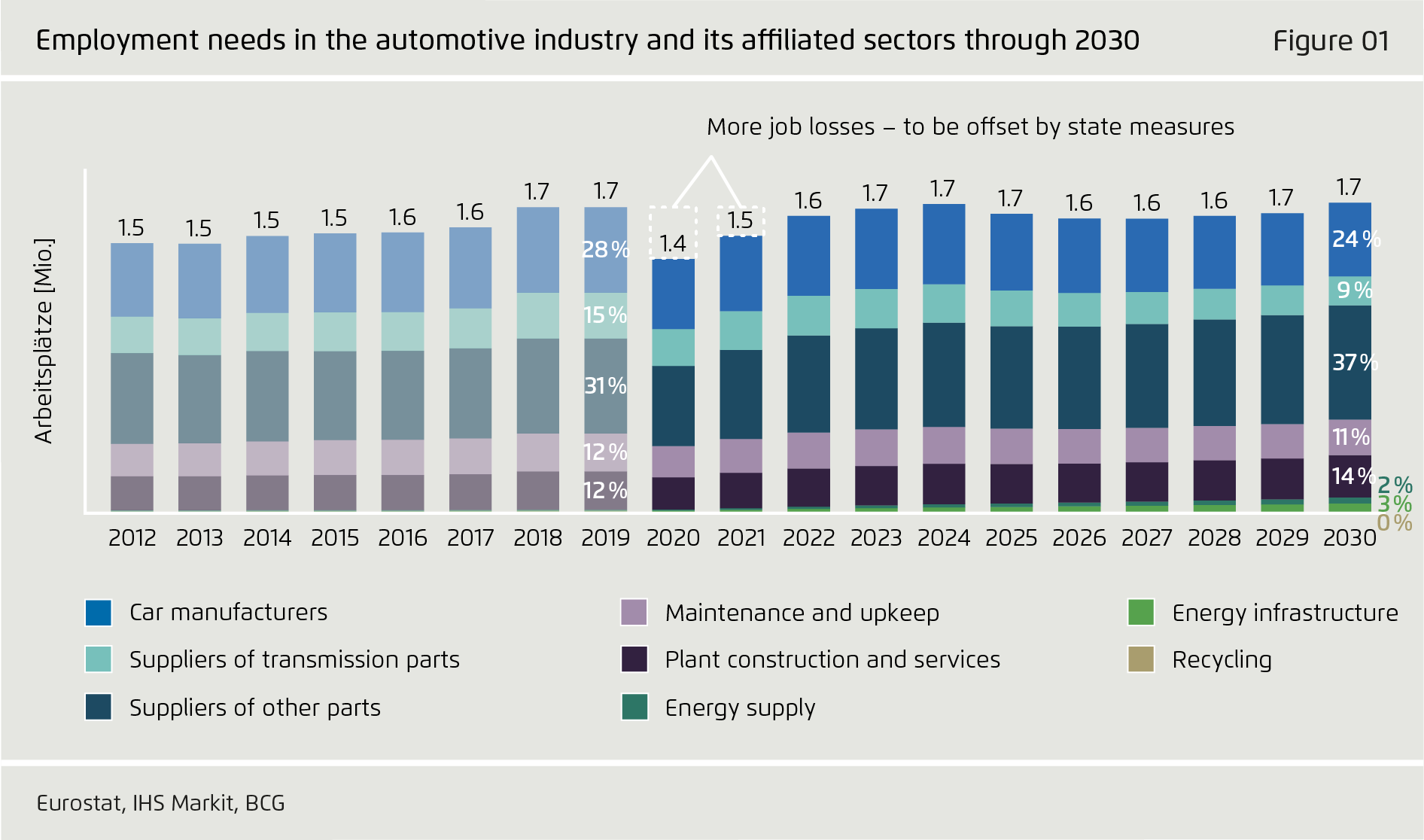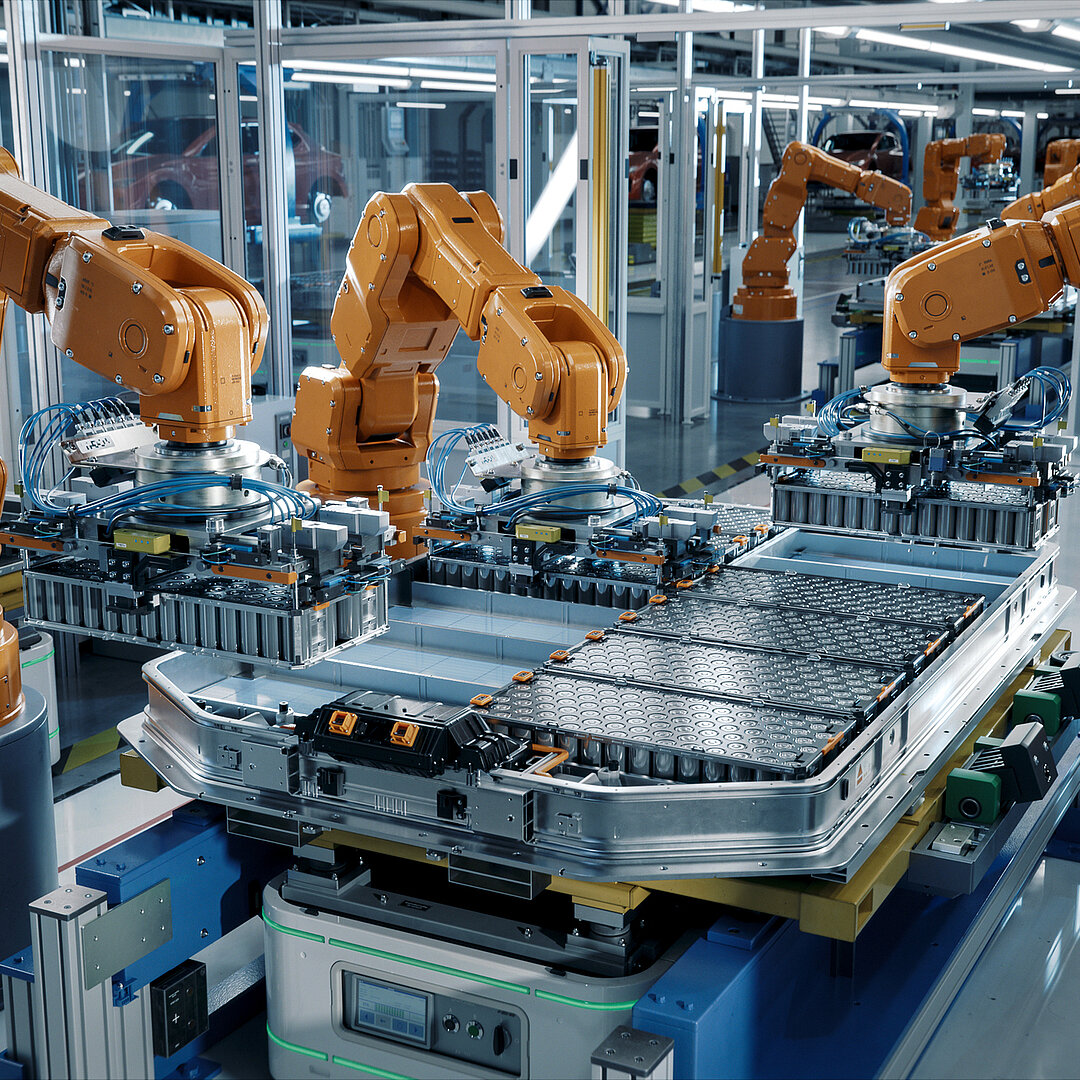-
The rise of electric vehicles is just one of several factors transforming jobs in the automotive sector.
A range of factors are already changing vehicle manufacturing and employment in the automotive sector, and will do so even more intensely in the future, including networked and self-driving vehicles, integrated mobility systems, more stringent climate protection regulations and productivity enhancements for Industry 4.0.
-
The transformation will have only a minor impact on the number of jobs in the automotive sector.
In fact, the size of the workforce on the whole is likely to grow slightly (+25,000 jobs). However, this net figure conceals large changes within individual subsectors. Especially in traditional automobile manufacturing, we anticipate a strong reduction in employment (-180,000 jobs). Upstream suppliers of non-powertrain-specific parts will benefit in particular from battery production (+95,000 jobs). In addition, numerous jobs related to the electric-vehicle charging infrastructure will be created (+70,000 jobs).
-
Required skill profiles in the automotive sector will undergo fundamental change, creating an enormous need for retraining in tandem with a growing demand for skilled labour.
The transformation of the automotive sector will create some 260,000 new jobs, especially in battery production, software development and charging-infrastructure operations. Taking personnel needs arising from retirement and employee turnover into account, more than 800,000 new positions will need to be filled before 2030. This is nearly 50 % higher than the equivalent figure from the past ten years. At the same time, many jobs will undergo changes or be eliminated altogether. Almost 760,000 workers need to retrain, and the retraining needs for one-third of these workers are significant.
-
East German states will benefit most from the transformation.
While the size of the automotive workforce in 2030 will be similar to that in 2019 in most areas of Germany, East German states are anticipated to see a 9 % increase (+16,000 jobs). This is predominantly attributable to decisions regarding the location of battery cell production.
-
Policymakers should assist the automotive sector while also ensuring a just transition for workers.
In order to create jobs and manage changes in affected regions, policymakers should provide targeted support to companies. At the same time, it is important to ensure that Germany remains attractive as a location for investment in new productive capacities. Access to venture capital and skilled workers is essential for new firms to take root. In addition, the public and private sectors should collaborate to retrain workers with outmoded skill profiles. Strategic support for transformation is indispensable at the state and federal levels.
Powering the Automotive Jobs of the Future
How the electrification of transport and other trends will change jobs in the automotive sector up to 2030 – and what this means for policymakers

Preface
A number of studies have already been conducted on how the energy transition will impact employment in the automotive sector. Past studies have typically had a narrow focus on the employment effects stemming from electric vehicles. But the transformation involves a series of changes. These include the digitalisation and automation of production processes; integrated mobility systems; and networked and self-driving vehicles. With our study, we broaden the consideration of employment effects by exploring how the transformation will impact employment not only in the automotive industry but also in related sectors.
Perhaps our most salient finding is that we expect no net employment losses or gains. Some subsectors will see significant employment declines – while others will flourish. As part of this “creative destruction” (Schumpeter), some factors of production will have to be reorganised. Some workers will need to acquire new skills. New jobs will be created in new locations, while old ones will disappear in places that workers and their families call home.
The implications of these changes for the life histories of workers and their families should not be ignored. Policymakers need to enact wise labour market policies to ease such frictions. Identifying such policies was one major aim of this study.
Key findings
Bibliographical data
Downloads
-
Powering the Automotive Jobs of the Future
How the electrification of transport and other trends will change jobs in the automotive sector up to 2030 – and what this means for policymakers
All figures in this publication
Employment needs in the automotive industry and its affiliated sectors through 2030
Figure 9 from Powering the Automotive Jobs of the Future on page 01

Main trends at a glance
Figure 11 from Powering the Automotive Jobs of the Future on page 02-07


![Preview for Effect of trends on employment in the automotive industry and in its affiliated branches through 2030 [thousands of jobs]](/fileadmin/AutomaticFiles/825/Abb_08.png)
![Preview for Regional job effects [thousands]](/fileadmin/AutomaticFiles/825/Abb_09.png)



